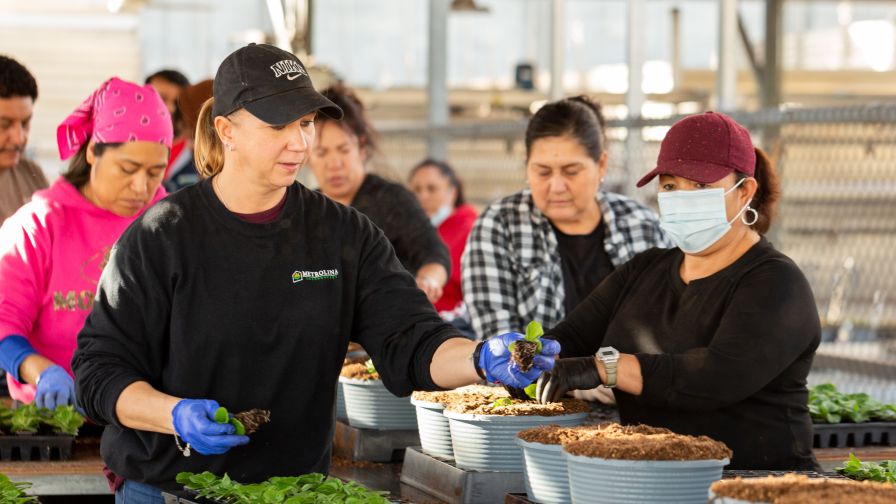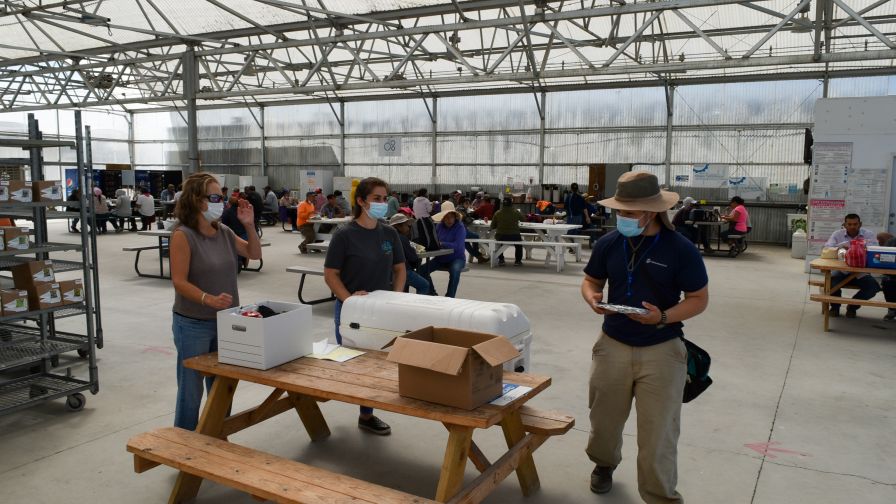Why Training and Development Are the Cornerstone of Retaining Your Workforce

Metrolina Greenhouses is investing in its people with training classes and opportunities for professional development. Photo: Metrolina Greenhouses
Editor’s note: This is the third article in a three-part series on labor solutions. The first article can be found here, and the second article can be found here.
The tables have turned when it comes to workforce recruitment and retention. In the past, an employer in any industry could offer a candidate a job with decent compensation and benefits. If it was the right fit, the candidate accepted the offer. Now, candidates want more than money and benefits. They want opportunities for training and development.
The modern workforce is not comfortable working in the same position for several decades. They want to learn about different facets of the business, hone their skills in multiple departments, and grow as professionals in their field. Candidates are evaluating what they can do for the company, but also what the company can do for them.
“It’s much more complex than saying no one wants to work anymore or the Great Resignation,” says Geneiva McNeale, Training and Development Manager for Metrolina Greenhouses. “People really do want to work, but they don’t want to work for a company where they feel like there isn’t a place for them. They don’t want to work for little pay, poor benefits, or in a toxic environment.”
Metrolina Greenhouses at the Forefront of Labor Retention
McNeale says Metrolina Greenhouses created strategies several years ago to focus on the growth and development of its workforce.
While training a new hire, the employees are asked to use a method called “Tell, Show, Do, Review, and Teach You.” This means that the trainer gives an overview of a task and the purpose of it, then demonstrates how to complete it. Next, the trainee does the task under supervision, then reviews any questions or adjustments with the trainer. The last step is for the trainees to teach back the process to the trainer, step by step.
“It reduces the potential for mistakes, and it helps the new hire feel connected to their leader,” McNeale says of the process. “It makes them feel confident that they will be successful. The idea of the teach-back process is that it employs active learning, so it should help reduce the amount of repeat training needed.”
She says employees in leadership positions have taken additional leadership classes on how to provide their staff with direction while avoiding micromanagement. The leaders help their teams develop self-reliance, so they do not need to ask for approval and confirmation for every task.
“There are classes to provide feedback in a way that’s meaningful to the person receiving the feedback, so they take it as a gift instead of as a criticism,” she says.
McNeale says Metrolina is in the early stages of a learning management system. The company contracted with a third party to develop a content library. Some content is pre-packaged and some is created in-house. She describes it as a “Netflix for training classes” that Metrolina can build over time to provide continuous development opportunities for the team.
The leadership team at Metrolina sees the need for at-the-ready training classes on topics such as loading shipping carts, transplanting combo pots, and safety guidelines. The modules have interactive slides to engage with learners.
“We can start to have people on different learning paths,” McNeale says. “If you’re a general laborer but you’re interested in getting into the assistant grower position, there will be a path that will show the competencies, skills, and knowledge you need to have to be qualified for that role.”
AmericanHort Aids in Professional Development
AmericanHort is stepping in to help employers and employees streamline professional development practices. The organization is developing a certification program for technicians, sections growers, and head growers, says Amy Ballard, Education Program Specialist. She expects the program to launch in mid to late 2023.
“The ability to train quickly is something we keep hearing from the industry,” she says. “Many growers are struggling to create internal programs that help train employees efficiently. Through this certification program, the additional horticultural training boosts employee confidence and helps growers get their teams up to speed with minimal investment.”
AmericanHort’s connector groups from the greenhouse, nursery, retail, and landscape industries saw the need for the workforce to be up to speed on horticulture foundations. Ballard says this approach, which includes training tools from growers, academics, and industry professionals, is necessary to continue bringing knowledgeable individuals into the industry.
“We needed something quick, accessible, and affordable to get people trained and a certification program fit the need,” she says.
Each module will include approximately 13 hours of course material. The instructional material will be online, but there will be opportunities for hands-on demonstrations and skills assessments learners will have the opportunity to complete with their employer as they go. Additional hands-on experiences will also be available at AmericanHort’s events, such as Cultivate and the Plug & Cutting Conference.
The topics covered will vary depending on the level of the certification. A person in the entry-level technician program learns basic skills, such as watering and recognizing pests. A section grower will need to know how to schedule crops in the greenhouse and oversee technicians. A head grower will need to understand lighting, irrigation systems, budgets, and management.
These courses can be tailored to any operation to fit its specific needs, Ballard says. Motivated individuals may sign up for the class themselves, or employers can refer their employees. Members of AmericanHort will encounter discounted rates.
“This certification program is designed for newcomers and industry veterans alike,” she says.

Skagit Horticulture shows its employees how much they are valued by hosting Employee Appreciation Days every quarter. Photo: Skagit Horticulture
Skagit Offers Great Company Culture
Company culture also factors into training and development, says Rose Vogel, Human Resources Manager for Skagit Horticulture in Mount Vernon, WA. Skagit has an open-door policy to welcome employees and create two-way communication between workers and managers.
About 98% of Skagit’s employees are Latinx, Vogel says, and they feel comfortable in the workplace. They are not hesitant to speak up when necessary, and their supervisors make them feel heard. In the past, it was challenging to get workers involved in safety committees or talk about their attendance. Now, the company culture is collaborative and cohesive.
“If they want to talk to me, they can,” Vogel says. “It’s open. We have a good culture.”
She says it is important to recognize that Latin women are subjected to machismo, a sense of masculine pride. Skagit has worked to break the barrier and empower women, who now fill most of the company’s lead positions.
“It’s not that they don’t want to apply for it. They need support because their culture does not empower them,” Vogel says. “They’re hidden gems. You can help them get over the hurdle.”
Skagit wants its employees to know that they are valued. When the air quality is poor, for example, Skagit leaders hand out masks. The company uses Ganaz, a software service, to text its employees. The texts are used for safety messages, such as a heat warning and encouraging the workers to drink plenty of water.
Martha Gonzalez, Marketing Manager for Ganaz, says the tool can also be used to gather feedback from employees, such as company culture assessments.
“It makes the employees feel valued and shows that the company cares about their wellbeing,” Gonzalez says. “There are open lines of communication. Employees can respond to the text messages with questions for HR. The employee doesn’t have to speak English. They can send a message themselves in their language, and it gets auto-translated.”
Skagit offers various types of internal training clinics and supports employees who find external training that they would like to attend. All members of the human resources department are bilingual or trilingual to ensure that employees receive the support they need, Vogel says. The company also hosts quarterly employee appreciation days, such as a barbecue, and fun competitions between departments to keep spirits high.
Employees Thrive in Metrolina’s Company Culture
McNeale says Metrolina revamped its orientation for new employees, so they have a welcoming experience and a smooth transfer to their manager from the get-go. It can be a little awkward transitioning into a new company culture, she says, so Metrolina works to ensure that new employees feel welcome.
“We bend over backwards to make sure that our plants are in an environment where they can grow, thrive, and they are nurtured to their needs,” McNeale says. “Just like plants, our team members need the right environment. The new crop of team members coming in year after year contributes to our success factor beyond just our sales.”
Companies should make the impression to new candidates that they are in the right spot, including compensating them fairly and offering a work-life balance.
“We’ll get them into a space where they don’t feel like they have to just learn the job today, but they’ll have opportunities to continue to learn,” she says.
One eye-opening class McNeale taught is called “Generations in the Greenhouse.” This class brings together all four generations of workers — baby boomers, generation X, millennials, and generation Z — to learn about each other’s generational traits and preferred methods of communication.
For example, a member of generation X may have grown up with many responsibilities because both parents worked full-time. That employee may value self-reliance. However, a millennial worker may have grown up with more parental supervision. Due to their upbringing, a millennial employee may value collaboration more than others.
“This helps to identify that some of these generational traits are not just personality quirks, or someone not having common sense,” McNeale says, “but rather a cultural norm that they were brought up to embody.”
This class helps employees identify different mindsets among their coworkers and understand why they may disagree sometimes. By making them aware of generational differences, employees can work together more effectively.









